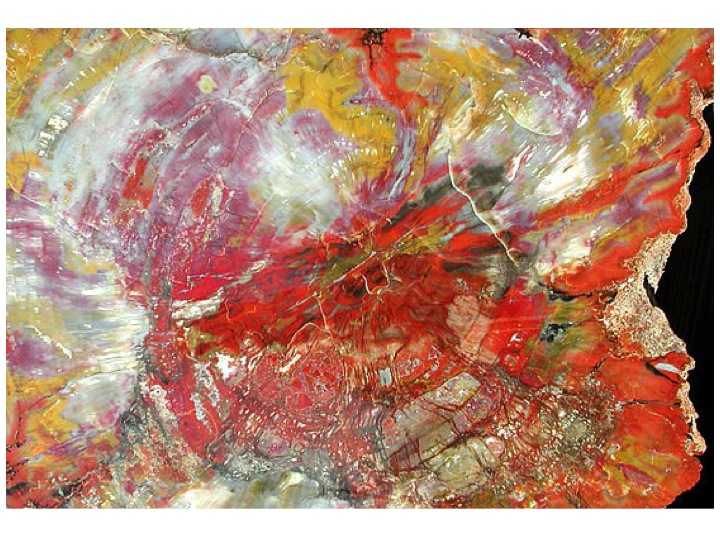The Petrified Forest is in Petrified Forest National Park, which east of Holbrook, northern Arizona. The exposures of rock strata in this park are part of the Chinle Formation, which based on fossils, are of Late Triassic age (225 to 220 m.y.a.). [As suggested by one of my former students, Matt Ventimeglia, who recently visited the park and sent me many of the images shown below, perhaps the “Petrified Forest“ could also be referred to as “Triassic Park.”] Some of the fossils, which are on view at the museum at the northern part of the park, are shown below. These fossils include petrified logs, ferns, cycads, ginkgoes, phytosaurs, large amphibians, small pterosaurs, and early dinosaurs.
The Petrified Forest (shown by the red dot) was located 4 degrees north of the equator (shown by the green line) during the Late Triassic (218 million years ago), when \ the Pangaea Supercontinent existed. Even since that time, the area of the forest has been slowly creeping northward and westward, via continental drift, which was the result of plate tectonics.
The Tepees in the north-central part of the park are exposures of the Blue Mesa Member of the Chinle Formation. The colorful bands of mudstone and sandstone were deposited during the Late Triassic, when the area was part of an extensive tropical floodplain. Image courtesy of Matt Ventimeglia--2023.
Three images showing petrified tree trunks and associated fragments of petrified wood. The first two images were taken by the author, about 20 years ago. The third image is courtesy of Matt Ventimeglia. Most of the “long” trees are Araucarioxylon arizonicum.
Two images showing sliced sections of petrified “wood” that were slowly “petrified”/”agatized” (i.e., replaced) by underground solutions containing colorful silica material.
Phytosaur skull (image courtesy of Matt Ventimeglia—2023).
Placerias hesternuscopy (image courtesy of Matt Ventimegila—2023).
Rauisuchid (left) and aetosaur (right) with a small pterosaur on its back (near the far wall).
The following information is copied from signage at the museum: “Rauiscdhids (raw-ih-SOO-kids) ranked as the top terrestrial predators of the Late Triassic, thanks to huge skulls armored with powerful biting jaws and 3 inch (7.6 cm) long serrated teeth. Some rauisuchids grew up to 20 feet (6 m) in length. Pauisuchids provide an excellent example of convergent evolution. Though their body plans were similar to meat-eating dinosaurs, like Tyrannnosaurus and Allosarus, who lived later during the Jurassic and Cretaeous, rauiscuhids are more closely related to crocodiles than to dinosaurs.”
The following information is copied from signage at the museum: “Aeteosaurs (AY-e-to-SAWRS) were 3-18 feet (1.-6 m) long, omnivorous reptiles with broad, flat bodies protected by plate-like osteoderms. Some species had large spikes on their sides or back that were possibly used for defense and species recognition. Aetosaurs had sturdy limbs and small skulls with a pointy snout used to root in the soil for plants, roots, and invertebrates. Desmatochus is the largest known aetosaur, reaching lengths of 18 feet (6 m). Although the first fossils of this species were found in Texas, it is relatively common” at the Petrified Forest in Arizona.
Closeup of a duck-size pterosaur (a model) mentioned in regard to the previous image (i.e., the specimen is displayed on the back of the aetoeosaur).
I could not find any information pertaining to the scientific name of this small pterosaur. This is most likely because the specimen/model is based on only a lower jaw bone (with teeth intact), and not enough of the specimen is present for a positive identification as to genus. Nevertheless, it is the only pterosaur remains found in the Petrified Forest fauna. For your information, the largest pterosaur of all time lived near the end of the Cretaceous Period and was as tall as the modern-day African giraffe.
If you are ever in the neighborhood of the Petrified Forest, do yourself a favor and allow time (one day) to visit this very interesting place.











No comments:
Post a Comment